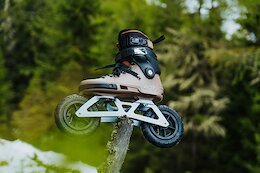How Skjelmose Bested Pogačar at Amstel Gold
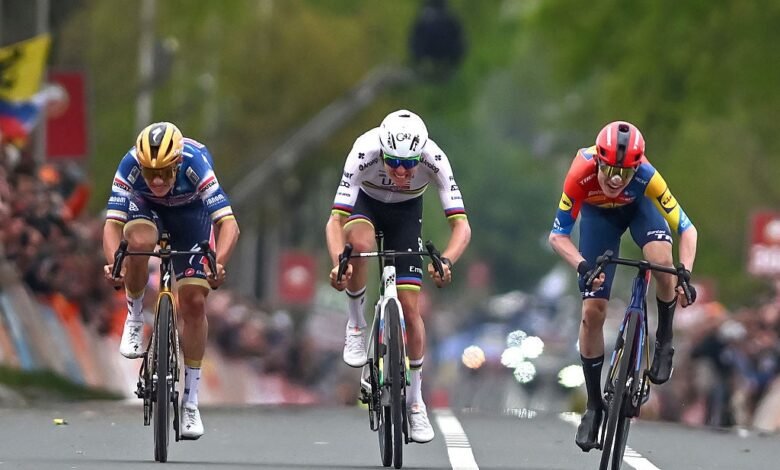
“], “filter”: { “nextExceptions”: “img, blockquote, div”, “nextContainsExceptions”: “img, blockquote, a.btn, a.o-button”} }”>
Tadej Pogačar is human, Remco Evenepoel is back, and Mattias Skjelmose can beat both of them in a sprint. Those were the takeaways from this year’s Amstel Gold Race, a Dutch classic that is often one of the best races of the year.
The world champion came in as race favorite, while Evenepoel, having just returned to racing after a long recovery stemming from a serious crash last December, was still an unknown quantity. Skjelmose was the underdog, a strong rider of course, but not the expected winner.
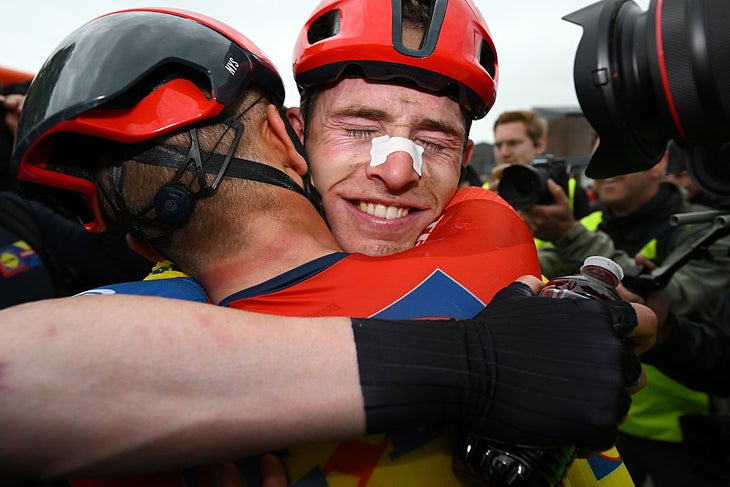
There were a number of second-tier favorites on the start line of Amstel Gold — namely Wout van Aert, Tom Pidcock, Thibau Nys, and Ben Healy — but the world champion was head and shoulders above the rest. Pogačar had just finished second at Paris-Roubaix, and Amstel Gold was a race that, in contrast to Roubaix, completely suited him.
The 2025 edition of Amstel Gold featured 3,200 meters of climbing in 256 kilometers. There were no less than 34 climbs throughout the course, including the infamous Cauberg with 2.5 km to go. With a million different ways to win, it was anyone’s guess as to when Pogačar would attack. But it was actually a different rider who lit the race on fire, a former world champion named Julian Alaphilippe.
Alaphilippe’s Daring Attack Sets the Stage
With 47.7 km to go, Brandon McNulty shot to the front of the peloton and led through a sharp right turn onto the Gulperberg. It looked like a planned attack for Pogačar, but Alaphilippe beat him to the punch when the Frenchman attacked up the left-hand side of the road. The pair sprinted up the steepest section of the climb, immediately getting separation from the rest of the field.
We don’t often see attacks this sharp from Pogačar, who did somewhere around 13w/kg for 30 seconds. The world champion was grimacing in Alaphilippe’s wheel, but he had the gap that he was looking for, and now it was on the peloton to chase.
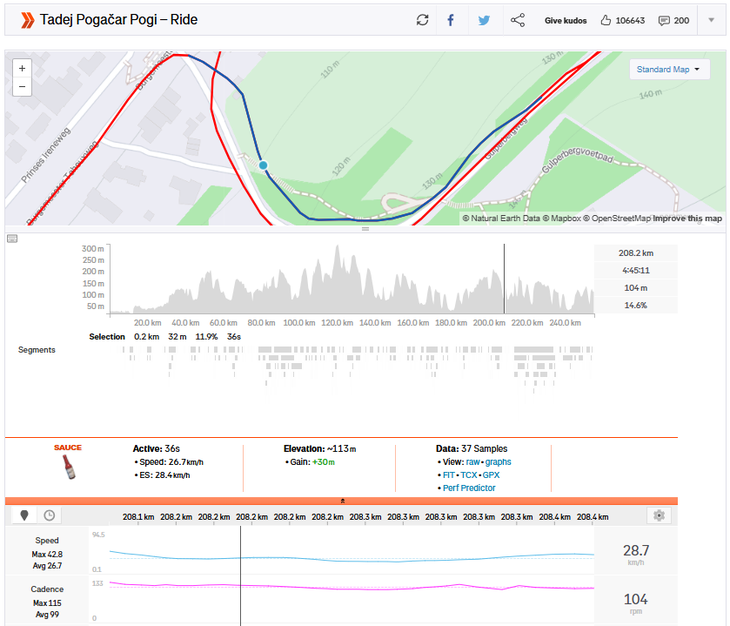
Pogačar – Attack on the Gulperberg
- Time: 32 seconds
- Estimated Average Power: ~900w (14w/kg)
- Ben Healy: 36 seconds at 700w (10.8w/kg)
We have to highlight McNulty’s effort here because it shows the importance of positioning and teammates in the key moments of the race. Five-hundred meters before the Gulperberg, Pogačar was out of position, sitting 10-15 wheels behind Lidl-Trek who were leading the peloton. But then, McNulty looked back and saw Pogačar on his wheel before moving up in the wind just before the climb. As we can see in McNulty’s power file, this was a massive effort at over 700w. These are the kinds of race-saving efforts that often get overlooked in Pogačar’s race-winning performances. Of course, he is one of the greatest cyclists of all time, but when you watch him race notice how often he enters a key sector in perfect position on the wheel of one of his UAE Team Emirates-XRG teammates.
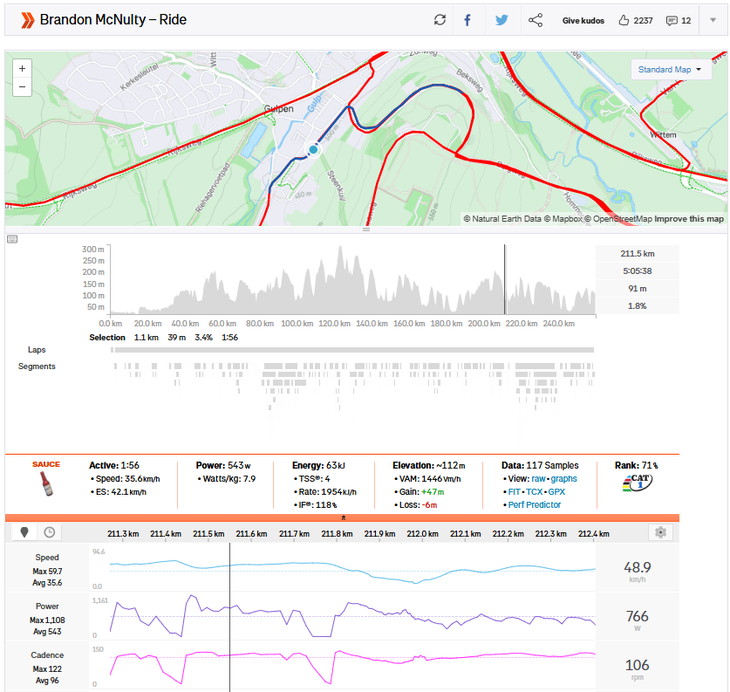
McNulty – Leadout into the Gulperberg
- Time: 20 seconds
- Estimated Average Power: 729w (10.6w/kg)
- Peak Power: 1,108w (16w/kg)
It wasn’t long until Alaphilippe was dropped on the next climb. Pogačar didn’t even put in an attack, it looked like he just rode at his own pace. With 40 kilometers to go, I was about to turn the TV off. Pogačar had gone solo and he already had a 30-second gap. Race. Over.
Or so we thought. Over the next 8 km, Ilan Van Wilder set a vicious pace on the front of the chase group. The Belgian kept Pogačar’s gap at 30 seconds, keeping the race alive for his teammate in Evenepoel. If you’ve ever wondered what it’s like to sit in the wheels at Amstel Gold, here is McNulty’s power file from this 12-minute period. Remember, this was when McNulty had a teammate up the road (Pogačar), so he was sitting at the back of the chase group and doing the least amount of work possible.
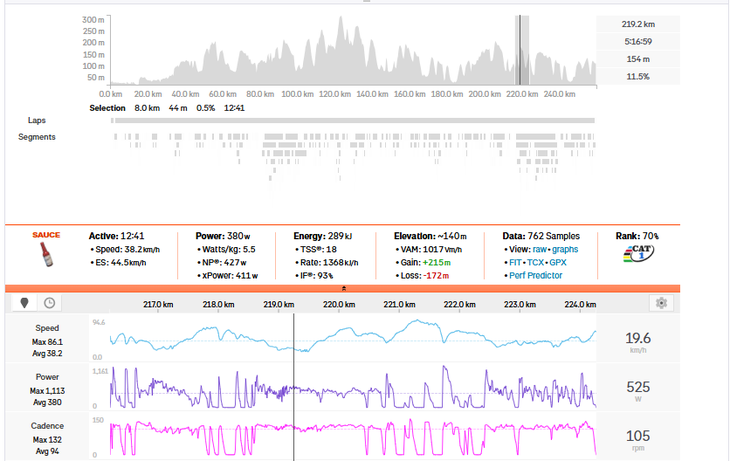
McNulty – Sitting in the Chase Group
- Time: 12:41
- Estimated Average Power: 380w (5.5w/kg)
- Normalized Power: 427w (6.2w/kg)
With 32 km to go, Skjelmose attacked over the top of the Keutenberg when the gap to Pogačar was still 28 seconds. It was a move that looked to be doomed, especially when the Dane failed to bring the gap down at all over the next 5km.
Once again, it looked like the race was over. Pogačar would win, Skjelmose would be second, and the chase group would fight it out for third. But the race situation completely changed again when Evenepoel attacked with 26 km to go. The Olympic champion went up the right side of the road with a clean pair of heels, bridging the 10-second gap to Skjelmose in less than a kilometer.
With 20 km to go, Pogačar led through the finish line with one lap to go. Evenepoel and Skjelmose had closed the gap to 13 seconds while the chase group was a further 16 seconds behind. Next came the Geulhemmerberg, and this was another turning point in the race. After bleeding time for the last 15 km, Pogačar suddenly extended his gap to 23 seconds over the 1.1 km climb. While the world champion was emptying his tank on the climb, Evenepoel and Skjelmose continued pushing up and over the top of the climb.
It was at this moment that you could see the difference between each of the three groups. Pogačar was pushing with everything he had left, the chasing duo maintained a steady threshold effort, and the chase group continued attacking each other, first with Healy, and then with Pidcock attacking over the top.
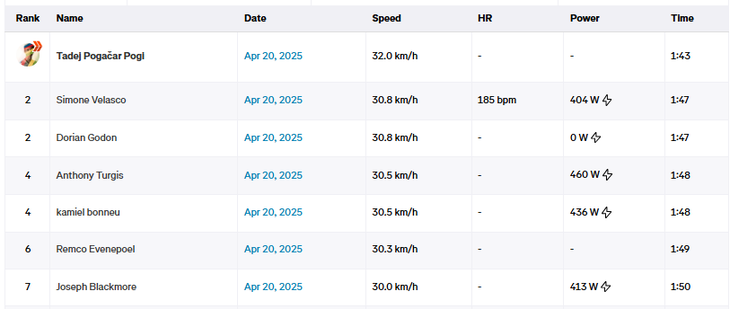
Pogačar – Geulhemmerberg with 18 km to go
- Time: 1:43
- Estimated Average Power: ~470w (7.3w/kg)
- Evenepoel: 1:49 at ~460w (7w/kg)
- McNulty: 1:53 at 451w (6.5w/kg)
With 14 km to go, the gap to Pogačar started tumbling. Evenepoel and Skjelmose were motoring while the world champion was floundering. We don’t see this often, Tadej Pogačar struggling to maintain his effort, and now it looked like he was going to get caught.
When the gap reached 8 seconds with 9 km to go, Pogačar seemed to give up his solo effort, taking a drink before the inevitable catch. The world champion removed himself from the aero position and kept looking over his shoulder at the chasers. With 8 km to go, Evenepoel made the catch, attacking straight over the top of Pogačar and forcing him into an all-out sprint.
For the next 7.5 km, there were three riders at the head of the race: the world champion, the Olympic champion, and the underdog in Skjelmose. All three riders took their turns at the front, but it was clear that Pogačar was exhausted. For one of the few times in his career, Pogačar didn’t look good, and he was probably just trying to make it to the sprint.
Skjelmose continued pulling, but it was Evenepoel who did the highest amount of work. The chase group was only 40 seconds behind, so they couldn’t mess around for too long at the front. No one in the lead group attacked on the flats, and no one attacked on the Cauberg. It was all coming down to a three-up sprint.
After out-sprinting Van Aert in Wednesday’s De Brabantse Pijl, Evenepoel was full of confidence with his finishing effort. Pogačar has quite a good kick himself, and so does Skjelmose.
With just under 300m to go, Pogačar rose up out of the saddle, looking like he was starting his sprint. The world champion hadn’t launched yet, but it seemed like his body language tipped off Evenepoel into starting his sprint. The Belgian launched onto the right-hand side of the road with Pogačar and Skjelmose in his wheel. But there was still over 200 meters remaining, and that’s when Pogačar started to come out of Evenepoel’s draft. The world champion took the lead, but then he had to sit down. His legs were fading, and so were Evenepoel’s. And then through the center of the road, Skjelmose hit the front with no more than 25 meters to go. There were only centimeters between them in the bike throw, but centimeters is all it took as Skjelmose’s tire that crossed the line first ahead of Pogačar’s.

He had done it. Mathias Skjelmose had won Amstel Gold. Not only that, but he had beaten Pogačar and Evenepoel in one of the best races of the season.
Power Analysis data courtesy of Strava
Strava sauce extension
Riders:


